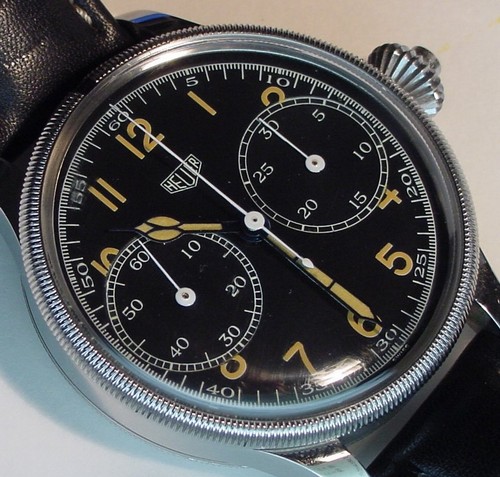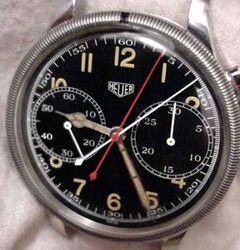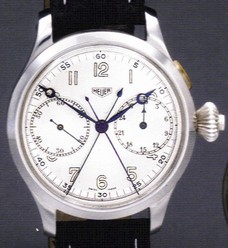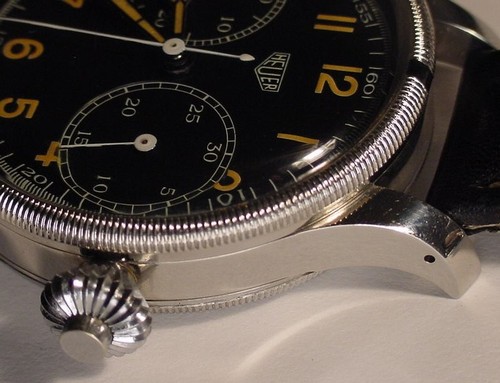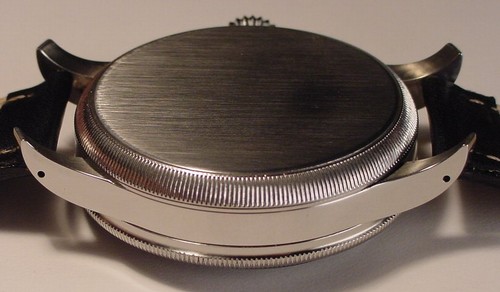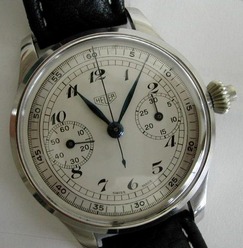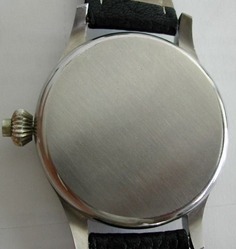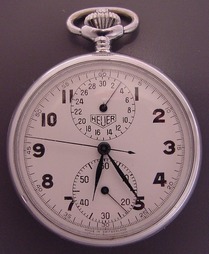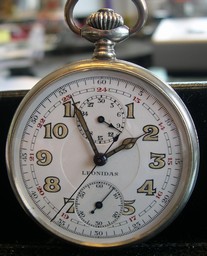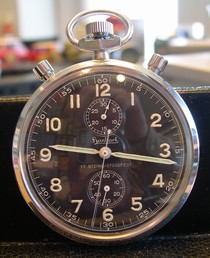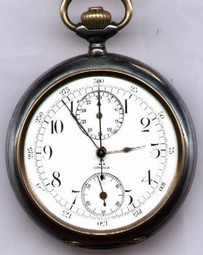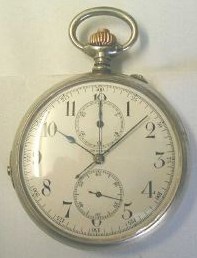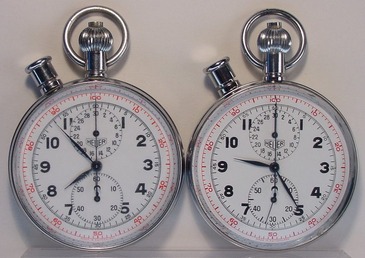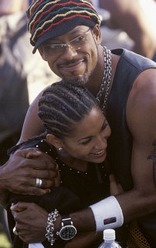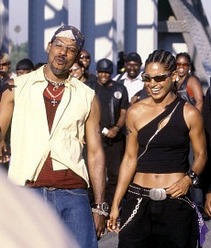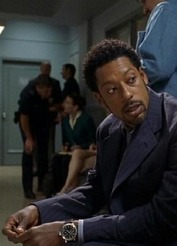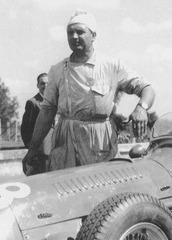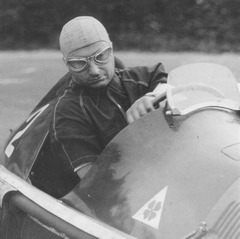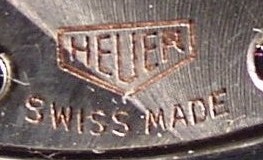|
Since October
2002, approximately 20 oversized chronographs
bearing the "Heuer" name have been offered or sold
through ebay or other websites. These chronographs
have been sold as vintage "Heuer" timepieces, with
prices in the range between $3000 and $4800. These
chronographs are typically listed as "vintage" or
New Old Stock (NOS) timepieces, and often described
as having some association with the "Targa Florio"
(a Sicilian automobile race), Grand Prix racing, in
general, or automobile Rallyes. Over the past
several months, there has been considerable
controversy about whether these chronographs are
genuine Heuer chronographs, made by Heuer in the
1950's, or "fakes", being produced currently in
Eastern Europe. In May 2003, we presented the key
arguments in this debate, which led us to conclude
that these chronographs are probably modern-day
reproductions, and not vintage Heuer timepieces. We
have recently had further conversations with
reliable sources, including representatives of
TAG-Heuer itself, which have led us to conclude
that these oversized chronographs are, in fact,
"fakes". Following are a
series of questions and answers regarding these
oversized chronographs. We will update this section
from time to time as we learn more about these
chronographs and as market conditions may
change.
What types of oversize "Heuer" chronographs are
currently being sold? Most of the
oversize chronographs currently being offered are
one-button
chronographs,
with continuous seconds at 9:00 (nine o'clock) and
a 30-minute recorder at 3:00 (three o'clock). The
button in the crown controls the stopwatch -- with
start, stop and reset to zero. There are also
some split-second chronographs being sold
(illustrated below). These are two-button models,
with a pusher at 2:00 (two o'clock) controlling the
split-second function. The button in the crown
controls the basic start-stop-reset
functions. ABSOLUTELY NOT --
These oversized chronographs have been produced in
the last couple of years (so they are not
"vintage"), primarily by craftsmen in Eastern
Europe and Germany (so they are not "Heuers").
These oversize
chronographs are being made in at least three
places -- Prague (in the Czech Republic),
in
Ustka
(a city in Poland), and in the Black Forest region
of Germany. Case-making is something of a cottage
industry, and in all likelihood, pocket
chronographs are being re-cased and converted into
oversized wrist chronographs in several additional
locations. We are most
familiar with the operations being conducted in
Poland and the Czech Republic, and will focus on
case-makers working in those markets. To the extent
we have reliable information, we will also discuss
the reproductions being made in Germany.
Which ones are coming from Poland and which ones
come from the Czech Republic? How you tell them
apart? And what about these German ones?
Most of the
pieces sold on ebay over the last year have come
from a case-maker in Prague. The distinctive
feature of these chronographs is the coin-edge
bezel, with the black stripe marker, Ýand
the screw-back, which also has a
coin-edge. It takes some
expensive equipment and highly skilled workers to
produce the coin-edge finishes and screw-backs on
the Prague pieces. Working in steel is far more
difficult than working in gold or silver, and these
cases actually represent an extremely high level of
case-making skill. The ones coming
from Poland (illustrated below) do not have a
rotating bezel and are snap-back models. The ones from
Prague come from a single craftsman, who works
alone. (We have not spoken with him, so we do not
have the details of what he is doing.) We have less
information about the German operations, though we
have received detailed descriptions of the
chronographs being produced there. There are
additional shops producing these oversized
reproductions. This is somewhat
complicated, but here are the basic
steps: For the Heuers
currently on the market, a one-button model is
the favored "donor". If the
case-maker will be making a split-second
chronograph, then, of course, the "donor" must
be a split second pocket chronograph. The Heuer
Reference 11.204 is the "industry standard". The real issue is
the price of the new case that is produced to house
the chronograph. You can find the pocket
chronographs in the $200 to $400 range, with the
genuine Heuers selling at the top of this range.
The dials can be refinished in the $50 to $100
range. Producing the new case is time-consuming and
the most expensive part of the
operation.
Are the guys who are producing these chronographs
open about what they are doing? We have not
spoken with the case-makers in the Czech Republic
and Germany, so we cannot comment on how they are
operating. We have heard that these shops are
offering their re-cased chronographs at watch
fairs, in Munich, and usually disclosing that they
are reproductions. We have spoken
with the case-maker working in Ustka, Poland, and
he is entirely open about what he is doing.
Whenever he sells a re-cased timepiece on ebay, it
appears that he indicates clearly that the piece
has been re-cased, and he has a very good feedback
rating on ebay. He also advertises that individuals
can send their old pocket watches to be
re-cased. It would appear
that the problems do not really arise as much with
the gentlemen who are producing these re-cased
chronographs, as with their customers who are
re-selling them as "vintage", "originals" or "New
Old Stock" timepieces.
Lately, most of these chronographs are being
offered and sold in the United States. How do they
get from Eastern Europe or Germany to the United
States? This is where it
gets interesting. The central
market for these oversized chronographs, other than
the internet, is Munich, where large watch fairs
are held regularly. Munich is centrally located
within the region where the cases are being
produced, and these fairs are very well attended.
At a typical Munich watch fair, there will be
several dealers offering these oversized
chronographs, with each seller having a selection
of a few pieces. Recently, it has become common
knowledge at these fairs that these chronographs
are reproductions, and they are offered and sold as
such. In fact, they are thought of as something of
a novelty item, rather than as a serious,
collectible chronograph. Recently, the
main buyers of these oversized chronographs have
been dealers located in the United States. While it
may be well-known at these fairs, and in the
European dealer network generally, that these
oversized chronographs are "fakes", word is only
beginning to spread in the United States and many
other markets. So when these dealers return to the
United States, they are able to offer them as NOS
pieces and create some history to accompany the
watches. In addition to
being offered at the European watch fairs, these
chronographs may also be sold by the case-maker
directly to customers. These customers may be
individual collectors or dealers who then resell
the chronographs as vintage NOS pieces.
So what is this "history" that the United States
dealers create for these chronographs?
The typical story
is that these chronographs were produced by Heuer,
in the 1950's, for a grand prix or rally team and
"put away" for many years by a keen collector. The
story often includes references to the chronograph
having something to do with the Targa Florio race
or being produced for Juan-Manuel Fangio and his
team. Those offering the watches proceed with the
story that a small "cache" of these chronographs
has been discovered recently and is being released
into the market slowly. Of course, this
history is a complete fabrication -- the
chronographs were not produced by Heuer in the
1950's; they were produced in Eastern Europe or
Germany just a few months ago. They are being
released slowly because there is a limit on how
many the case-makers can produce and there is a
limit on how many the market can view and absorb,
without the fraud becoming too obvious.
Do these dealers know the real history of these
chronographs? Absolutely. They
are buying them directly from the people who are
making them, with full knowledge that they are
reproductions. I am told that their status as
"reproductions" or "fakes" is common knowledge in
the circles where these pieces are being offered
(primarily the Munich watch fairs). The dealers are
buying these pieces from the people producing them,
being told exactly what they are, and then making
up the "history" and representing them to be New
Old Stock pieces in order to realize higher prices
when they resell them. When they were first
introduced into the US market, typical selling
prices are around $3000 for the standard
(one-button) chronographs and over $4500 for the
split-second (two-button) versions. I have presented
the "facts" to two of the dealers located here in
the US, and they continue with their stories about
race teams, limited editions, collectors in
Germany, caches being found, etc. The story changes
a little from time to time, as they forget some of
what they have told me, but they continue offering
them as NOS / vintage / original
timepieces.
What are the names of the dealers that are selling
these fakes? We do not see any
real purpose in naming the dealers who are selling
these fake chronographs. In addition, there are
some reputable dealers selling these chronographs
that have absolutely no idea what they are selling.
Some of them have accepted the pieces on
consignment. Rather than
guessing which dealers are in on the scam and which
are innocent bystanders, all we need to know is
that if you are reading this page, then you will
know at least as much as any of the dealers and can
avoid buying one of these fakes (unless you
actually want to own one). Most of the
oversized chronographs have been offered by dealers
based in Southern California. They are being
offered on ebay, through internet watch dealers and
even in some reputable stores. As word is getting
out among the dealers, that these are "fakes", ebay
and the internet become the only channels of
distribution. Prices appear to be
declining.
So the Southern California connection explains
the stories about these chronographs being worn by
movie stars and celebrities? Correct. We know
that Orlando Jones wore one during the filming of
Biker BoyZ. We have also heard that Arnold
Schwarznegger owned one, though he made the mistake
of jumping in a swimming pool while wearing his.
These are not waterproof, so it had to be returned
to Europe for repairs.
OK -- enough about the movie stars on motorcycles.
Is it true that Juan-Manuel Fangio wore these
oversize Heuer chronographs when he drove in the
Targa Florio road races? Juan-Manuel
Fangio was one of the greatest racecar drivers of
all time, and had the distinction of being the
first five-time Formula One champion. We know that
he was fond of chronographs, and we see photographs
of him wearing chronographs in the pits, on the
racetrack and even while having a doctor fit him
with a plaster cast. Heuer had a
relationship with Fangio, and it seems that Heuers
were among his favorites. TAG-Heuer indicates that
Fangio wore a Heuer chronograph when he
participated in the Targa Florio road race, in the
early 1950's, and the company drew on this
association in designing and marketing its Targa
Florio chronograph (introduced in 1996, as part of
its Classic series). While there is
every reason to believe that Fangio wore a Heuer,
we have not been able to find any evidence that he
wore a chronograph resembling the oversized
chronographs being produced today. We have
inspected dozens of photographs of Juan-Manuel
Fangio, looking for the "Targa Florio" oversized
chronograph. YES -- he wore a variety of
chronographs, even during races and practices. NO
-- none of them resemble the fakes that are being
offered and sold as "the original Targa Florio"
chronograph. In simplest terms, this is a bit of
"history" being created by dealers attempting to
sell modern-day fakes.
If these oversized chronographs are reproductions
or fakes, how do they relate to the "Targa Florio"
chronographs being produced by TAG-Heuer today?
In 1996,
TAG-Heuer relaunched the "Targa Florio" chronograph
as part of its Classic series. The Targa Florio was
re-issued in tribute to Juan-Manuel Fangio, as
described above. These "Targa Florios" are the only
chronographs ever produced by Heuer under that
name. It appears that
the individuals producing the fakes took advantage
of TAG-Heuer's re-issue of the Targa Florios. Here
is the most likely scenario. When TAG-Heuer
reintroduced the Targa Florio in 1996, its
marketing materials used numerous vintage photos of
Fangio, Formula One cars, etc. But TAG-Heuer never
showed any photos of the chronographs that were the
basis for the design. (In fact, TAG-Heuer did not
publicly identify the actual chrongraph that was
the historic predecessor of the Targa Florio.) So
along come the people producing the "fakes", and
decided that they will take their design cues from
the new Targa Florio -- circular steel case, with
coin-edge rotating bezel; black dial with paint
round figures; fluted crown; etc. This all appears
to be a twisted case of "reverse engineering" --
with a piece produced in 2002, in Eastern Europe or
Germany, posing as the original which is said to
have inspired the re-issue in 1996. In this sense,
it appears that the re-issue inspired the forgery
of the "original". This spy-versus-spy stuff does
get confusing!!
So has Heuer ever actually produced oversized
chronographs or anything bearing any real
resemblance to these modern-day reproductions?
We do not believe
that Heuer has produced anything near the size of
the fakes that are flooding the market today. These
big boys are coming in at 48 mm, across the dial,
and 60 mm, from lug-to-lug. This is fairly typical
of today's oversized chronographs (for example, the
Hanharts, Glycines, Tutimas, etc.), but there is
nothing approaching this size in the old Heuer
catalogs (or in the memory of the old Heuer
watchmakers). Sure, the
earliest wrist chronographs (of the 1910's and
1920's) were approximately this size, but these
were really pocket watches with lugs and a strap
attached. It does not appear that Heuer produced
anything like these oversized chronographs during
the relevant periods (1950's and
1960's). In fact, there
were very few watch companies making oversized
chronographs during the 1950's. Several companies
produced oversized pilots' watches during the
1930's and 1940's (Hanhart, Junghans, Glasshutte
and Tutima come to mind), but relatively few
produced them in the 1950's (with Minerva and
Longines being two of the leaders in this area). In
simplest terms, there are no genuine oversized
Heuer chronographs from the 1950's or 1960's --
they are all fakes. The perspective
on the split-second chronographs is even simpler:
Heuer never produced a split-second wrist
chronograph, large or small. So if it a
split-second wrist chronograph marked "Heuer", it
is a fake. No need for any forensic work on this
one! I can count at
least six or eight of these "Heuer" chronographs
that have been sold and there are probably at least
10 or 12 more that are currently on the market (or
waiting in the wings). I believe that there are
also some that have been sold privately, away from
ebay or the internet. Because of ebay
"shills" and sales outside ebay, it is difficult to
determine exactly how many of those listed on ebay
have actually been sold. Also, some of these
chronographs may be on consignment with more than
one dealer, so it is difficult to be certain about
how many different pieces are being
offered. It is interesting
that the production and sale of fake oversized
"Heuers" comes as part of a recent trend that has
seen several hundred reproductions of oversized
chronographs in the market. The trend probably
started three or four years ago, with the Minervas,
Omegas and Longines, and Heuer was added to the
collection of fakes with the past year or
so.
So if there are less than 20 of these fakes,
with only about half of them sold, what's the big
deal? Putting aside the
purely legal issues (which are very complicated and
best left to the lawyers in the group) and the
ethical issues (which may be best addressed by the
ethicists in the group), from the perspective of
the collector, it is all about honesty and
deception. Let's walk through a couple of
examples. If a collector
owns a Reference 701 pocket chronograph, or a
Reference 11.204 split-second pocket chronograph,
and decides to have it put into a
newly-manufactured wrist chronograph case with a
re-done dial, I would say that this is the
collector's own business. Clearly, TAG-Heuer could
take issue with the "Heuer" name being used on a
re-done (rotated) dial, but to the extent that our
collector keeps the re-cased chronograph for his
own use and pleasure, it is difficult to see how
anyone is harmed. At the other end
of the spectrum, let's consider the dealer who
obtains a Leonidas pocket chronograph, from the
1940's, that has an unmarked movement. The dealer
sends it to a craftsman in Eastern Europe, who
produces a new case and has the dial rotated /
refinished. For discussion purposes, let's assume
that, on the instructions of the dealer, the
craftsman marks the case "Ed. Heuer & Co." and
adds a few "Heuer" and "Valjoux" marks to the
previously unmarked movement. Of course, as
instructed, he also has the dial changed from
"Leonidas" to "Heuer". Our friendly dealer then
lists it for $3000, and describes it as New Old
Stock, vintage, original, etc. A novice collector
makes the purchase, after telling the dealer that
he only wants to buy the chronograph if it is a
genuine, vintage Heuer and receiving assurances to
this affect from the dealer. Would anyone not agree
that this is a "big deal". That is one of
the ironies of this whole messy situation. Some of
the modern-day reporductions are fantastic pieces.
If the dealers would sell them for what they are
(and get rid of the illegal "Heuer" logos and
marks), then maybe everyone would be
happy. The version being
produced in Prague is the only one that I have seen
"in the metal", so I can only comment on that one.
The design of the case, dial and hands was
fantastic and the build quality of the case was
absolutely superb . . . first rate by anyone's
standards. The movement was pristine, and it kept
time incredibly well -- within one minute per
month. It had a genuine Valjoux 76 movement and was
one of the best timekeepers of any Heuer that I
have checked. In some respects, it is the superb
quality of the construction that allows the dealers
to pass them off as real. As one of the dealers
wrote to me, they are absolutely "Heuer
quality". I have not
inspected any of those made in Poland, but they
certainly look nice in the photographs. One of the usual
approaches to defining "market value" begins with
the phrase "what a willing buyer would pay,
assuming that he is fully informed." For a
beautiful looking, well-built, hand-made
chronograph, with a genuine Valjoux movement, I
believe that there are plenty of people who would
pay more than $2000 for one of the Prague pieces,
knowing exactly what they are (and are not). While
some buyers might like the Heuer logo, there are
others who find forgery offensive, and would pay
even more if the dial were left blank. This kind of
price would represent a fair mark-up above the
price being charged by the case-makers assembling
these pieces. Supporting this
approach, I have heard of serious Heuer collectors
being told that they are fakes, and still wanting
to buy one around the $2500 price level. As one of
them asked me, "What other chronos at this price
level look this good and are built this well?"
Similarly, a leading auction house recently sold an
oversized split-second chronograph, marked "Heuer",
for over $5000. The purchaser was advised that it
was likely a reproduction; he still inspected the
piece and decided that it was a "buy" at that
price. So if the
question is "What are they worth?", then the answer
must be "Whatever a buyer is willing to pay". The
key is that the buyer has a right to know what he
is buying, rather than being sold fictitious
"history" and "originality". The first
indication that something was "wrong" came when a
Southern California dealer offered me a
split-second, two-button version. Of course, it
came with the usual story of being from the early
1950's and having been "put away" by a collector
many years ago, etc. The case was marked "Ed.
Heuer" and the chronograph had the same case and
dial as the other oversized chronographs then being
offered. The problem was
that the movement in this split-second chronograph
was marked "Heuer-Leonidas".
The Heuer / Leonidas merger only occurred in 1964,
so this chronograph must have been "put together"
some time after that date. Also, the movement was a
Valjoux 9, which Heuer only began using in the
1960's. It hardly required a detective to conclude
that this was not a vintage piece from the 1950's.
Most of the
evidence was outlined in our "Great Debate" table,
which we published in May 2003 -- the oversized
chronographs did not appear in any old Heuer
catalogs, long-time Heuer watchmakers had never
seen or heard of them, the paint on the dials
looked too fresh, and some of the markings on the
movements were strange looking. (For example, I
examined one chronograph with a "Swiss Made" mark
on the movement. I have seen
hundreds of Heuer movements, but I had never seen
one marked "Swiss Made". In addition, this mark was
in a strange place on the movement and the
"quality" of this particular marking looked
weak.) Once you conclude
that one piece is a "fake", then you start looking
at the others more critically. Pretty soon, you
start to see more problems and suddenly you realize
that they are all fakes. It's not as though 10
could have been produced by Heuer 50 years ago and
10 identical pieces were produced a few months ago,
in Eastern Europe. In fact, it didn't take long to
realize that all 20 must be the reproductions.
What makes you so certain now about these being
"fakes"? Previously, you had some questions and
referred to this as being a "debate" or
"controversy". It all became
clear during the past couple of weeks, based on
three conversations with experts. Since we launched
OnTheDash.com, in February 2003, the oversized
chronograph that we have shown has generated many
questions. (It is ironic that we have received more
inquiries asking about the history and availibility
of this chronograph than any other timepiece shown
on the website . . . They really are great looking
chronographs!!) Similarly, these oversize
chronographs have been the subject of many
questions on our Discussion Forum. People
considering spending $3000 or more for one of these
should have the real facts, not the
ìhistoryî being created by dealers
trying to move their inventory. |
